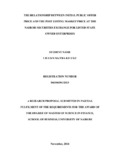| dc.description.abstract | Initial Public Offer (IPO) is the first sale of stock by a private company to the public with
the objective of raising funds for expansion and growth. Studies have shown that most
IPOs long run under performance of listed companies in the developed economies is
because of a time-varying phenomenon. According to Rock and Ritter (1986), under
pricing is necessary to induce uninformed investors to participate in IPO offering when
faced with adverse selection from informed investors. This often leads to first day price
not reflecting a fair value of the IPO. Ritter (1991) and Loughran and Ritter (1995) posit
that a long-term investor who buys shares of a firm right after it goes public may realize
abnormal negative risk-adjusted returns and long run underperformance. This study tried
to show whether these findings apply to initial public offers issued at the NSE with the
overall objective of determining the relationship between IPO price and post listing
market price of listed State Owned Enterprises on the NSE in Kenya. The study is
empirical in nature and involves the use of secondary data available at the NSE and CMA
data base. Out of the 58 companies registered and trading at the NSE, only 3 were chosen
for the study; that the listed State Owned Enterprises. Data analysis involves the use of
descriptive statistics such as mean, variance, standard deviation, Pearson‘s correlation
coefficient and regression analysis. All the firms that were chosen for the study were
underpriced which constituted to 100% of the population. The results of the study found
that there is a positive relationship between IPO price and the first day price with a
significance level of + 0.0110 and that under pricing also has a positive relationship with
IPO pricing. The conclusion is that IPO price affects post listing market price. R2 of
0.9485 showed that 94.85% is explained by the model with a lower standard error of
estimate of 3.869. This study would be useful to various stakeholders such as institutions
intending to list, policy makers, investors and the academia .Policy Makers would also
use the study to design policies that guide the operations in the market with respect to IPO
pricing and information dissemination in prospectuses about the companies intending to
list in future. The findings of this study would also be important to academia as would
help them identify any gaps existing in the initial public offer process. | en_US |

